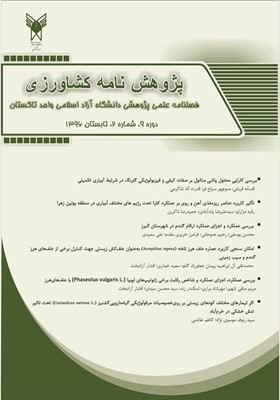امکان سنجی کاربرد عصاره علف هرز تلخه (Acroptilon repens) بهعنوان علفکش زیستی جهت کنترل برخی از علفهای هرز گندم و سیبزمینی
محورهای موضوعی : پژوهش نامه کشاورزیمحمدتقی آل ابراهیم 1 , پیمان جعفرزاد گللو 2 , سعید خماری 3 , افشار آزادبخت 4 *
1 - دانشیار گروه زراعت و اصلاح نباتات، دانشکده کشاورزی و منابع طبیعی، دانشگاه محقق اردبیلی
2 - دانشجوی کارشناسی ارشد دانشکده کشاورزی و منابع طبیعی، دانشگاه محقق اردبیلی
3 - استادیار گروه زراعت و اصلاح نباتات، دانشکده کشاورزی و منابع طبیعی، دانشگاه محقق اردبیلی.
4 - دانش آموخته دکتری علوم علف های هرز دانشگاه محقق اردبیلی
کلید واژه: گندم, عصاره آبی, خرفه, گاوپنبه, تلخه,
چکیده مقاله :
جهت بررسی اثر عصاره آبی گیاه تلخه به عنوان علف کش زیستی بر طول ساقه ، طول ریشه و وزن کل خرفه، گاو پنبه و گندم و وزن متوسط غده و عملکرد تک بوته سیب زمینی، آزمایشی به صورت فاکتوریل در قالب طرح کاملا تصادفی در چهار تکرار در گلخانه تحقیقاتی دانشکده کشاورزی و منابع طبیعی دانشگاه محقق اردبیلی در سال 94-1393 انجام شد. در این آزمایش فاکتور اول شامل غلظت های مختلف (0 (شاهد)، 5، 5/7، 10، 15 و 20 درصد) عصاره آبی تلخه و فاکتور دوم نیز گیاهان مختلف بودند. نتایج تجزیه واریانس داده های آزمایشی نشان داد که طول ساقه ، طول ریشه و وزن کل گیاه در خرفه، گاو پنبه و گندم تحت تاثیر غلظت عصاره تلخه، گونه گیاهی و اثرات متقابل آن ها هم به صورت کاربرد عصاره در خاک و هم کاربرد عصاره بر روی گیاه قرار گرفتند. بر اساس نتایج، در غلظت 20% عصاره آبی تلخه به دو صورت کاربرد در خاک و روی گیاه، بیشترین طول ساقه در گندم و کمترین طول ساقه در گاوپنبه و خرفه مشاهده شد. طول ریشه گندم، خرفه و گاوپنبه در غلظت 5% عصاره آبی تلخه به صورت کاربرد در خاک از نظر آماری با تیمار شاهد تفاوت معنی داری نداشت ولی در غلظت 10%، رشد گیاهان مختلف برابر با هم و در غلظت های بالاتر از 10% کمترین رشد به خرفه و گاوپنبه تعلق داشت. افزایش غلظت عصاره آبی تلخه تا سطح 20% در شرایط کاربرد در خاک و کاربرد بر روی گیاه به ترتیب باعث کاهش 33 و 51 درصدی ماده خشک کل گیاه گندم نسبت به تیمار شاهد شد اما این مقدار برای گاوپنبه 84 و 91 و برای خرفه 84 و 84 درصد بود.
In order to study the effects of Russian knapweed extract as a biological herbicide on stem length, root length and total weight of Purslane, Common yellow mallow and wheat and the average weight of the tuber and yield of a single plant of potato, a factorial experiment was conducted in a completely randomized design with four replications in a research greenhouse of Faculty of Agriculture and Natural Resources, University of Mohaghegh Ardabili in 2015. In this experiment, the first factor consisted of various concentrations (0 (control), 5, 5/7, 10, 15 and 20%) of the Russian knapweed aqueous extract and the second factor was the different plants. The analysis of variance results of experimental data showed that stem length root length and total plant weight in Purslane, Common yellow mallow and Wheat were affected by concentration of Russian knapweed extract, plant species and their interactions both extracts were applied to the soil and the application of extract on the plant. Based on the results, in the concentration of 20% of the Russian extract of the knapweed, two applications in soil and on the plant, the highest stem length was observed in wheat and the lowest stem length was observed in Purslane and Common yellow mallow. The root length of wheat, Purslane and Common yellow mallow in 5% concentration of Russian knapweed aqueous extract in soil application was not significantly different from the control treatment but at 10% concentration, the growth of different plants was equal and in concentrations of more than 10% the least growth was attributed to Purslane and Common yellow mallow. Increasing the concentration of the Russian knapweed aqueous extract to 20% in terms of application in soil and application on the plant respectively, decreased 33 and 51% of wheat plant dry matter compared to control treatment but it was 84 and 91% for Common yellow mallow and 84 and 84% for Purslane. The average weights of tubers and the yield of single potato plant were not affected by the Russian knapweed aqueous extract.
_||_

